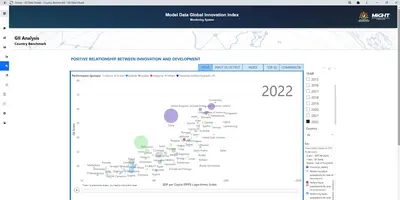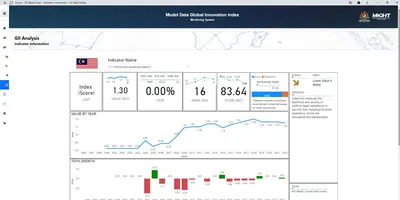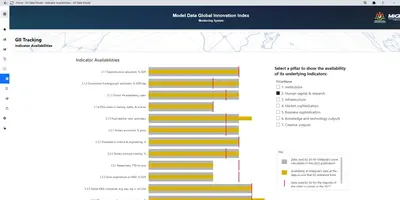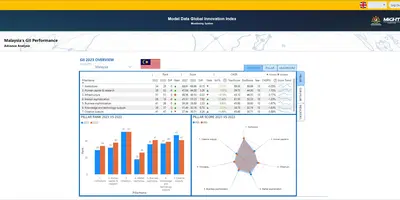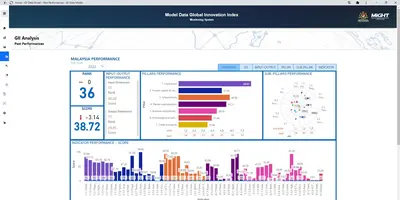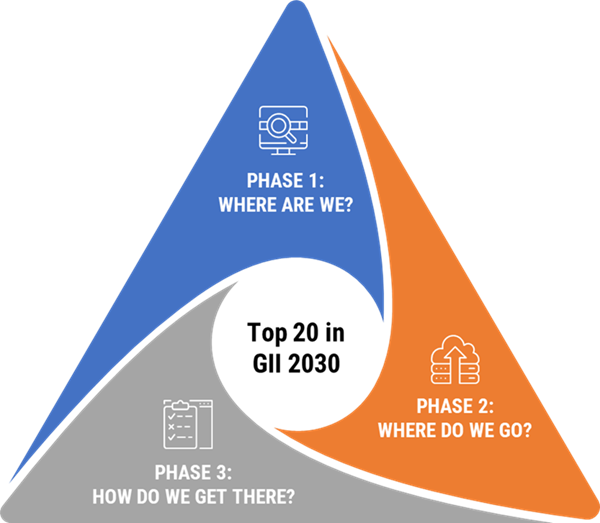
GLOBAL INNOVATION INDEX (GII)
The Malaysia Chapter
"KUALA LUMPUR, 11th September 2023 - Prime Minister Dato' Seri Anwar Ibrahim also know as PMX today presented the Mid-Term Review (MTR) of the 12th Malaysia Plan (12MP) at the Dewan Rakyat. The theme of the review is 'Malaysia Madani: Sustainable, Prosperous, High-Income,'. PMX has set a new Global Innovation Index (GII) target for Malaysia to rank 30th out of 132 economies by 2025.
The Global Innovation Index, or GII is a pioneering initiative brought to you by a collaborative effort between the World Intellectual Property Organization (WIPO), Cornell University, and INSEAD. This index serves as a crucial benchmark, evaluating and ranking the innovative capabilities of nations worldwide, especially Malaysia.
At our Webpage, we have assembled a wealth of information, data, and analyses about Malaysia’s and the world’s current status to help you understand the multifaceted dimensions of innovation. Explore the latest rankings of countries, delve into annual reports, and gain valuable insights into global innovation trends and best practices.
Our Webpage delves into a multitude of factors that contribute to innovation, ranging from research and development to investments in education, infrastructure, and technology. We also assess entrepreneurial activities and the protection of intellectual property, among many other essential aspects.
By providing this comprehensive overview, we aim to offer a clear perspective on how innovation can drive our nation (Malaysia) to positive change in various economic and social sectors. Nations that excel in the GII rankings are known for fostering innovation-friendly environments, leading to the development of cutting-edge technologies and solutions that impact society and economies in profound ways.
Policymakers, business leaders, researchers, and curious minds can all benefit from our Webpage’s extensive data. Through GII, we hope Malaysians to foster a better understanding of the pivotal role innovation plays in shaping the trajectory of countries and offer valuable insights to enhance the quality of life and global competitiveness.
Video source: www.wipo.int
Video source: MOSTI
Twelfth Malaysia Plan : 2021-2025
The Twelfth Malaysia Plan otherwise known as 12th Malaysia Plan and abbreviated as “12MP” (Malay: Rancangan Malaysia Kedua Belas – RMke-12), is a comprehensive blueprint prepared by the Economic Planning Unit (EPU) of the Prime Minister’s Department (PMO) and the Ministry of Finance. You can find more information about the GII in 12MP here specifically in [p.342, p.348, p.387, p.388 & p.391]
Top 10: The World’s Most Innovative Countries – Global Innovation Index 2023.
In the Global Innovation Index for 2023, Switzerland remains at the forefront, securing the 1st position for the 13th consecutive year. Sweden holds steady in 2nd place, while the United States slips to 3rd from its 2nd-place ranking in 2022. The United Kingdom maintains its 4th position, while Singapore climbs from 7th to 5th place.
Finland drops to 6th, and the Netherlands moves to 7th from 5th. Germany retains 8th place, Denmark rises from 10th to 9th, and the Republic of Korea falls to 10th from 6th in the previous year.
In summary, Switzerland, Sweden, and the United States remain innovation leaders, but there have been notable shifts in rankings, with Singapore and the Republic of Korea experiencing significant changes.
Video source: www.wipo.int
GII Report Summary
Conceptual Framework for the Global Innovation Index 2022
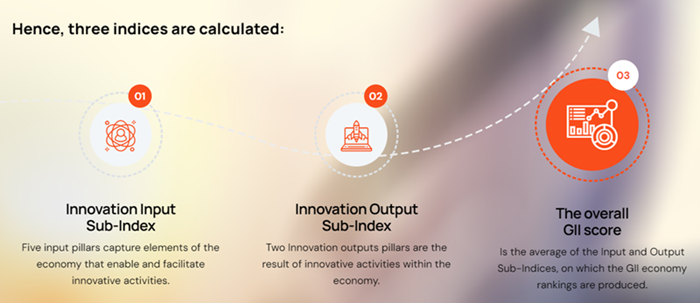
The Inter-Agency GII Competitiveness Monitoring Committee (JIPGII)
About The Inter-Agency GII Competitiveness Monitoring Committee (JIPGII)
Established in January 2021, the formation of this Committee is an initiative by the Ministry of Science, Technology, and Innovation (MOSTI), aligned with the Government’s aspiration in the Twelfth Malaysia Plan (12MP) to position Malaysia among the top 20 countries in the Global Innovation Index (GII) by the year 2025. The establishment of this committee is also seen as capable of providing impact and added value to the nation’s innovation ecosystem, further enhancing the country’s innovation performance effectively and efficiently through integrated inter-agency cooperation involving various ministries, departments, agencies, and private entities.
Through this committee, collaborative ties with the GII report publisher, particularly WIPO, can be established through strategic cooperation with the Intellectual Property Corporation of Malaysia (MyIPO), which is a WIPO member state.
The objective of establishing JIPGII:
- To implement and enhance the monitoring of competitiveness indices in a more systematic and effective manner to improve the country’s performance in the Global Innovation Index (GII) report;
- To ensure the accuracy and timely collection, storage, and updating of indicators by data custodians in the international database, thereby showcasing the actual achievements of the country; and
- To identify short-term, mid-term, and long-term targets to improve scores and elevate Malaysia’s position in the GII report.
PHASE 1a: MAPPING MALAYSIA’S STATE OF INNOVATION
Objective: Establishing Malaysia’s innovation ecosystem with its source and contribution of data to ensure comprehensiveness, accuracy and timeliness.
Status: √ DONE
PHASE 1b: COMMUNICATION MALAYSIA’S STATE OF INNOVATION
Objective:
- Coordinating the relay of data information required for GII indicators in a timely manner by National data custodians to the respective international databases and
- Informing National Stakeholders on Malaysia’s innovation strategies, initiatives and performance.
Status: √ DONE
PHASE 2: ASPIRING FOR MALAYSIA’S STATE OF INNOVATION
Objective:
- Benchmarking against global best practices of the GII and
- Setting the targets for Malaysia’s aspiration in GII.
Status: √ DONE
PHASE 3a: MONITORING MALAYSIA’S STATE OF INNOVATION
Objective:
- Ensuring the strategies and initiatives are on track and recommending and
- Updating annual data of the GII indicators.
Status: Currently we are at this stage!
PHASE 3b: IMPROVING MALAYSIA’S STATE OF INNOVATION
Objective: Identifying short, mid and long-term strategies and implementing initiatives towards improving Malaysia’s GII scores and ranking.
Status: –
INPUT PILLAR 1: INSTITUTIONS
- Pillar Lead: MPC
- Ministries: MOHR, MITI & KLN/Wisma Putra
- Agencies: CGSO, PEMUDAH, AGC, SSM, MDI, JDN, DOSM, MIDA, BHEUU, JTKSM, JPPM & EAIC
- Person In-charge:
- Name: Ilyana Norsaidah
- Tel. No: 03-79557266
- Email: illyana@mpc.gov.my
INPUT PILLAR 2: HUMAN CAPITAL AND RESEARCH
- Pillar Lead: ASM
- Ministries: MOE, MOHE & MOSTI (MASTIC, Bhg. PSTI, Bhg. PS, Bhg. TSA)
- Agencies: LHDN
- Person In-charge:
- Name: Teng Yu He
- Tel. No: 03-62030633
- Email: eng@akademisains.gov.my
INPUT PILLAR 3: INFRASTRUCTURE
- Pillar Lead: MRANTI
- Ministries: NRECC, KKD, MOT, MOF
- Agencies: MCMC, DOSM, JDN, MDEC, JSM &ST
- Person In-charge:
- Name: Nur Aliya Ayob
- Tel. No: 03-89982020
- Email: aliya@mranti.my
INPUT PILLAR 4: MARKET SOPHISTICATION
- Pillar Lead: MTDC
- Ministries: –
- Agencies: BNM, BURSA MALAYSIA & SECCOM
- Person In-charge:
- Name: Nor Halina Ghazali
- Tel. No: 03-21726000
- Email: halina@mtdc.com.my
INPUT PILLAR 5: BUSINESS SOPHISTICATION
- Pillar Lead: Cradle
- Ministries: MOHR, MOHE, MOF, MITI & MOSTI (MASTIC, Bhg. DANA)
- Agencies: MIDA, ASM, MyIPO, DOSM, MPC, BNM, JPK & MDEC
- Person In-charge:
- Name: Sitti Nursaadah Md Rusli
- Tel. No: 03-40458600
- Email: sitti@cradle.com.my
OUTPUT PILLAR 6: KNOWLEDGE AND TECHNOLOGY OUTPUTS
- Pillar Lead: MyIPO
- Ministries: OHE, MITI, MOF, MOSTI (Bhg. PTK)
- Agencies: DOSM, JSM, MCMC, PSM & MRANTI
- Person In-charge:
- Name: Meriam Nur Ahmad Hanbali
- Tel. No: 03-22998961
- Email: meriam@myipo.gov.my
OUTPUT PILLAR 7: CREATIVE OUTPUTS
- Pillar Lead: MIMOS
- Ministries: KKD
- Agencies: MATRADE, JDN, MyIPO, MPC, MYNIC & DOSM
- Person In-charge:
- Name: Siti Affida Zamry
- Tel. No: 03-89955000
- Email: affida@mimos.my
Reports on the Global Innovation Index
Dear readers and innovators, It is with great pleasure and enthusiasm that we open the doors to the prestigious collection of Global Innovation Index Reports. The Global Innovation Index (GII) is an annual report that has been published since 2007 and provides a comprehensive framework and a set of indicators to measure innovation performance of countries and economies around the world according to their innovation capabilities and outcomes, identifies their strengths and weaknesses, provides policy recommendations and best practices to foster innovation.
The GII report covers a wide range of topics related to innovation, including:
- INNOVATION RANKINGS : The GII ranks countries based on their overall innovation performance. It provides a comparative analysis of how nations are faring in terms of fostering innovation.
- INNOVATION INPUTS : The report assesses the inputs and enablers that contribute to a country’s innovation capabilities, such as investments in education, R&D, infrastructure, and information and communication technology (ICT).
- INNOVATION OUTPUTS : The GII evaluates the tangible and measurable results of innovation efforts, such as patents, publications, creative products, and high-tech exports.
- INNOVATION POLICY ANALYSIS : The report analyzes innovation policies and strategies implemented by countries to support and encourage innovation within their respective economies.
- INNOVATION IMPACT : The GII examines the impact of innovation on economic growth, productivity, and other developmental outcomes.
What is the Global Innovation Index (GII)?
The GII is an international innovation competitiveness report published annually by the World Intellectual Property Organization (WIPO), Cornell University, and INSEAD since 2007.
What does the GII measure and why is it important to a country?
The Global Innovation Index measures the innovation ecosystem of a country’s economy and provides insights into its strengths and weaknesses in innovation. Many countries use the GII to assess and enhance their innovation ecosystems, utilizing it as a reference in their economic plans and policies.
What is the GII framework?
The GII framework is divided into two (2) Sub-Indexes: Innovation Input and Innovation Output. The details are as follows:
- Innovation Input Sub-Index: Comprising five (5) pillars namely Institutions, Human capital and research, Infrastructure, Market sophistication, and Business sophistication.
- Innovation Output Sub-Index: Comprising two (2) pillars namely Knowledge and technology outputs, and Creative outputs.
What types of data are used in making GII score evaluations?
There are three (3) types of data used in GII data evaluation:
- Quantitative/objective data/hard data: This includes data obtained from public and private sources such as UNESCO, WIPO, Thomson Reuters, and others.
- Composite data/index: This comprises composite data from certain agencies and academic institutions such as the World Bank, UN Public Administration Network (UNPAN), International Telecommunication Union, and others.
- Qualitative data/survey/soft data: These are data obtained from surveys such as the Executive Opinion Survey conducted by the World Economic Forum, the Malaysian Productivity Corporation, and others.
What is meant by Innovation Input Sub-Index and Innovation Output Sub-Index?
The Innovation Input Sub-Index refers to factors that influence a country’s ability to innovate, such as human resources, research and development, and infrastructure. The Innovation Output Sub-Index refers to the outcomes produced by a country in the field of innovation, such as products and services, the export of high-technology products, and patents.
What is the most innovative country in the 2022 GII report?
Switzerland is the most innovative country in the world for 12 consecutive years followed by the United States, Sweden, the United Kingdom and the Netherlands.
What is the purpose of GII published?
- Analyzing the performance of the innovation ecosystem in 132 countries.
- Offering a framework based on seven cores for each country to enhance their respective innovation ecosystems.c. Supplying benchmarks on policies and best practices from an innovation perspective to enhance a country’s competitiveness internationally.
What does GII have to do with Malaysia?
Malaysia has made the GII a benchmark for measuring national innovation. Malaysia has been listed in the GII Report evaluation since 2007.
Do countries submit data directly to WIPO?
Malaysia does not contribute data directly to WIPO. The data used by WIPO is only taken from various sources of international organizations (such as reports and databases).
What are the benefits of GII?
- Provide a comprehensive overview of a country’s innovation ecosystem.
- Information sources regarding best practices, benchmarking initiatives that have been implemented by innovation-leading countries and the latest innovation trends at the international level.
- Source of information for international companies in the process of identifying suitable countries for them to make long-term investments.
What are the factors that affect the GII performance of a country?
- The actual performance of the country involved;
- Coordination of the GII framework;
- Data updating, treatment of outliers and missing data; and
- Countries involved in the assessment.
How is Malaysia performing in the GII?
Malaysia’s performance in the GII has generally ranged between 32nd and 37th. The country’s best position was 32nd in 2012, 2013, and 2015, while the lowest position was 37th in 2017. However, the overall score decreased from 45.9% in 2012 to 38.7% in 2022. Malaysia’s score rose again to 40.9% in 2023
What is Malaysia’s level of competence in GII?
The country’s efficiency level, when measured by the quality of innovation, is comparable to that of high-income economies. However, it is low due to the lower production of innovation output relative to the level of innovation investment (input).
Who is the data provider for GII?
Data providers for the GII include ministries, agencies, departments, companies, and individuals who submit data to international rating bodies. The data supplied is of a quantitative nature. The data sources used by the publisher can be accessed through the Appendix in the GII Report
Are all Ministries/Agencies/Departments involved in GII?
Yes, all ministries, agencies, and departments are involved in the GII. Those that have indicators and channel data directly to the GII are directly involved with the GII. However, other ministries, agencies, and departments also contribute indirectly, such as policy implementers who play a role in the national economic ecosystem.
How many indicators are evaluated in GlI?
The number of indicators assessed in the GII for the year 2022 is 81. The number of indicators may vary each year depending on the methodology adopted by WIPO for that year’s evaluation.
Which channel should the information/data be submitted to MOSTI regarding GII?
Any Information/data can be submitted to the following MOSTI officers:
- Name: Mr. Muhamad Baihaqi bin Ibrahim
Email : baihaqi@mosti.gov.my
No. Tel.: 03-8885 8110 - Name : Mr. Rudy Bin Nurdin
Email : rudy@mosti.gov.my
No. Tel.: 03-8885 8652
How is the GII ranking of a country is calculated?
The GII ranking of a country is determined by taking into account the average score between the Innovation Input Sub-Index and the Innovation Output Sub-Index. It shows the extent to which the innovation input that is implemented affects the innovation output for a country.
What are the methods and weights used to measure the GII index?
The method used to measure the GII index is Weighted Average. The weights assigned to calculate the GII index are 0.5 and 1.0, depending on the type of indicator. For a detailed explanation, please refer to the GII Report Technical Notes.
What is the definition of each indicator?
Definitions for each indicator can be found in the Appendix- Sources and Definitions of the GII Report.
How many economies/countries are involved in the GII assessment?
The number of economies/countries involved in the assessment may vary each year. In 2022, a total of 132 countries participated. A country is eligible for evaluation only if it has data coverage of at least 66% for the Innovation Input Sub-Index and 66% for the Innovation Output Sub-Index.
What are the targets set by the Government in the GII?
- Ranking of the top 30 economies in 2025 (12th Malaysia Plan).
- Ranking of the top 20 economies under the Knowledge and Technology Pillar in 2030 (MyDigital).
- Achieve a score of 40-43 in the Performance of Key Performance Indicators for Chief Secretaries, Chief Directors, Federal and State Government Secretaries.
What are MOSTI’s plans to improve GII’s performance in the future?
Owner and data contributor information for GII indicators will be periodically updated, and continuous monitoring will be conducted for initiatives identified to enhance the country’s performance in the GII. A ‘whole-of-government approach’ will be implemented to ensure cohesive cooperation and integrated information from all sectors.
Activities & Programs
